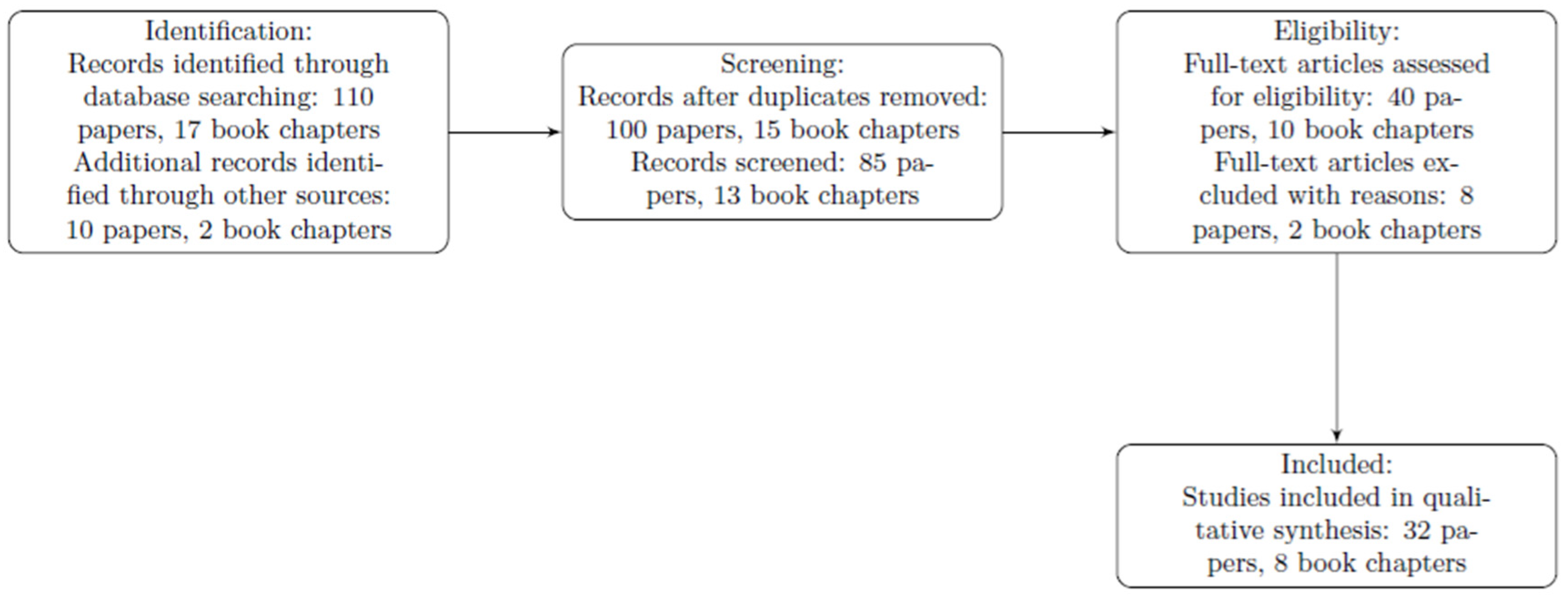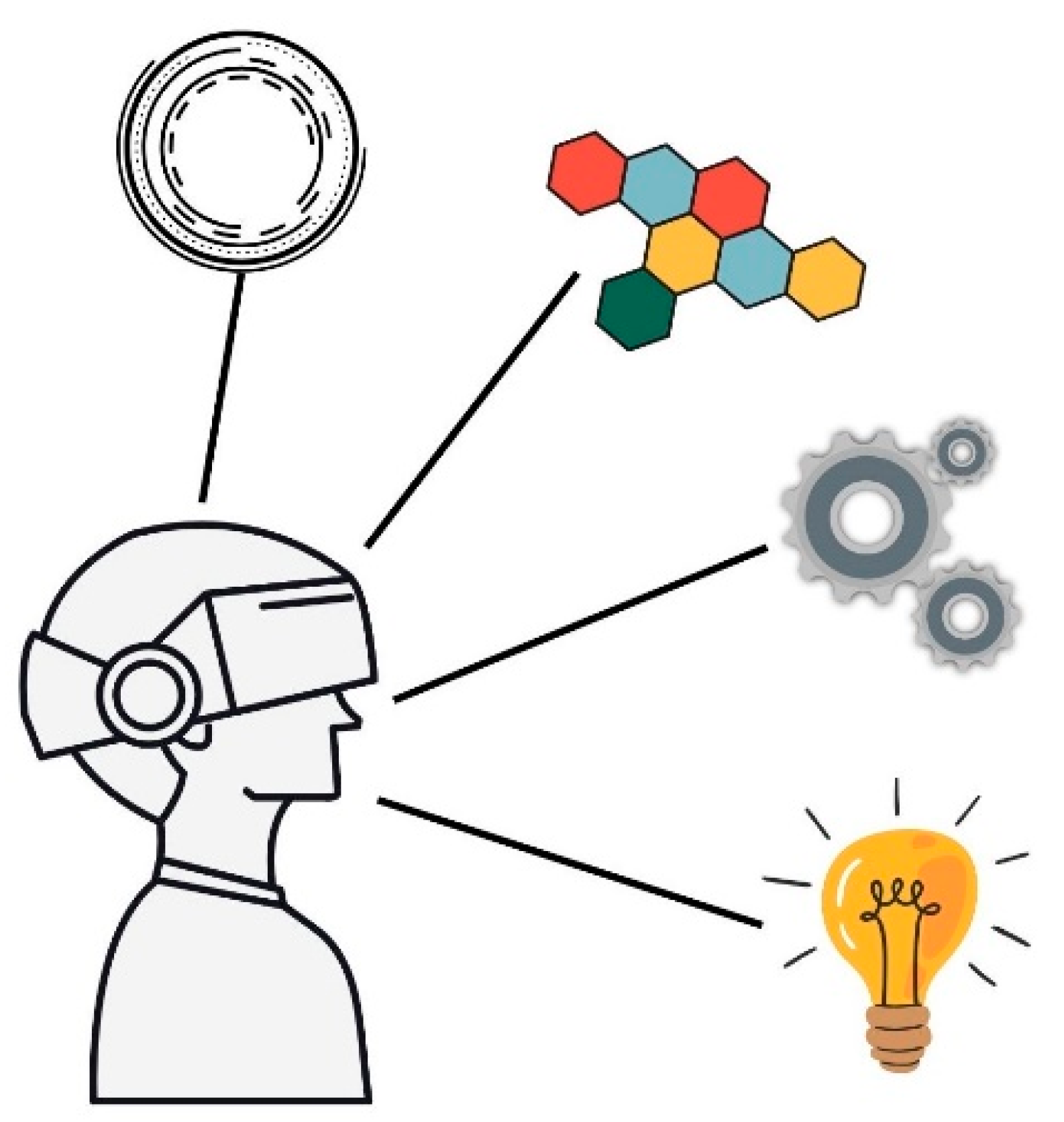AI-Enabled 6G Internet of Things: Opportunities, Key Technologies, Challenges, and Future Directions
Abstract
:1. Introduction
1.1. First-Generation (1G) Technology
1.2. Second-Generation (2G) Technology
1.3. Third-Generation (3G) Technology
1.4. Fourth-Generation (4G) Technology
1.5. Fifth-Generation (5G) Technology
1.6. Sixth-Generation (6G) Technology
2. Methodology
3. Artificial Intelligence Techniques for 6G Networks
3.1. AI-Empowered Mobile Edge Computing
3.2. Intelligent Mobility and Handover Management
3.3. Intelligent Spectrum Management
3.4. Terahertz Band Communication
3.5. Intelligent Communication Environment
3.6. Pervasive Artificial Intelligence
3.7. Ambient Backscatter Communications
3.8. Internet of Space Things with Cubesats and UAVs
3.9. Cell-Free Massive MIMO Communications
3.10. Tentative Timeline for 6G
3.11. Channel Estimation
3.12. Semantic Interoperability
3.13. Modulation Recognition
3.14. Intelligent Routing
4. AI-Enabled Intelligent 6G Network Applications
4.1. Smart Cities
4.2. Autonomous-Vehicle Communications
4.3. UAV Communication
4.4. Smart Robotic
4.5. Smart Agriculture
4.6. Virtual Reality
4.7. Online Video Games
4.8. Remote Surgery
5. AI-Enabled 6G Network Challenges
5.1. Channel Estimation
5.2. Network Traffic Prediction and Classification
5.3. Intelligent Routing
5.4. Radio Resource Management
5.5. Network Fault Management
5.6. Mobility Management
5.7. Network Botnet Detection
5.8. Network Energy Optimization
6. Future Research Directions
6.1. Computation Efficiency and Accuracy
6.2. Real-Time Video Analytics
6.3. Big Data Analytics for 6G
6.4. Robustness, Scalability, and Flexibility of Learning Frameworks
6.5. Hardware Development
6.6. Energy Management
6.7. Public Trust and Responsible Development
6.8. Human AI
6.9. AI-Enabled 6G for IoT
7. Discussion
8. Conclusions
Author Contributions
Funding
Data Availability Statement
Conflicts of Interest
References
- Akhtar, M.W.; Hassan, S.A.; Ghaffar, R.; Jung, H.; Garg, S.; Hossain, M.S. The shift to 6G communications: Vision and requirements. Hum.-Centric Comput. Inf. Sci. 2020, 10, 1–27. Available online: https://www.ncbi.nlm.nih.gov/pmc/articles/PMC7750912/ (accessed on 5 June 2024). [CrossRef]
- Elmeadawy, S.; Shubair, R.M. 6G Wireless Communications: Future Technologies and Research Challenges. In Proceedings of the 2019 International Conference on Electrical and Computing Technologies and Applications (ICECTA), Ras Al Khaimah, United Arab Emirates, 19–21 November 2019; pp. 1–5. [Google Scholar] [CrossRef]
- Gallagher, J.C.; DeVine, M.E. Federation of American Scientists. Available online: https://sgp.fas.org/crs/misc/R45485.pdf (accessed on 22 August 2023).
- Bakare, B.; Bassey, E. (PDF) A Comparative Study of the Evolution of Wireless Communication Technologies from the First Generation (1G) to the Fourth Generation (4G). Available online: https://www.researchgate.net/publication/355397163_A_Comparative_Study_of_the_Evolution_of_Wireless_Communication_Technologies_from_the_First_Generation_1G_to_the_Fourth_Generation_4G (accessed on 22 August 2023).
- Agarwal, A.; Agarwal, K. The Next Generation Mobile Wireless Cellular Networks—4G and beyond. Am. J. Electr. Electron. Eng. 2014, 2, 92–97. Available online: https://pubs.sciepub.com/ajeee/2/3/6/index.html (accessed on 23 August 2023). [CrossRef]
- Sahoo, S.S.; Hota, M.K.; Barik, K.K. 5G Network a New Look into the Future: Beyond All Generation Networks. Am. J. Syst. Softw. 2014, 2, 108–112. Available online: https://pubs.sciepub.com/ajss/2/4/5/ (accessed on 23 August 2023).
- Solyman, A.; Yahya, K. Evolution of Wireless Communication Networks: From 1g to 6G and Future Perspective. Available online: https://www.researchgate.net/publication/362397204_Evolution_of_wireless_communication_networks_from_1G_to_6G_and_future_perspective (accessed on 23 August 2023).
- Shahjalal, M.; Kim, W.; Khalid, W.; Moon, S.; Khan, M.; Liu, S.; Lim, S.; Kim, E.; Yun, D.W.; Lee, J.; et al. Enabling technologies for AI empowered 6G massive radio access networks. ICT Express 2023, 9, 341–355. [Google Scholar] [CrossRef]
- UMahamod; Mohamad, H.; Shayea, I.; Othman, M.R.; Asuhaimi, F.A. Handover parameter for self-optimisation in 6G mobile networks: A survey. Alex. Eng. J. 2023, 78, 104–119. [Google Scholar] [CrossRef]
- Ismail, L.; Buyya, R. Artificial Intelligence Applications and Self-Learning 6G Networks for Smart Cities Digital Ecosystems: Taxonomy, Challenges, and Future Directions. Sensors 2022, 22, 5750. [Google Scholar] [CrossRef]
- Farhad, A.; Pyun, J.-Y. Terahertz Meets AI: The State of the Art. Sensors 2023, 23, 5034. [Google Scholar] [CrossRef]
- Singh, P.R.; Singh, R.; Yadav, R.; Chaurasia, S. 6G networks for artificial intelligence-enabled smart cities applications: A scoping review. Telemat. Inform. Rep. 2023, 9, 100044. [Google Scholar] [CrossRef]
- Maduranga, M.W.P.; Tilwari, V.; Abeysekera, R. Improved RSSI Indoor Localization in IoT Systems with Machine Learning Algorithms. Signals 2023, 4, 651–668. [Google Scholar] [CrossRef]
- Deebak, B.D. Drone of IoT in 6G Wireless Communications: Technology, Challenges, and Future Aspects. 2020. Available online: https://www.semanticscholar.org/paper/Drone-of-IoT-in-6G-Wireless-Communications%3A-and-Deebak-Al-turjman/efb4a9ce2be6699605e4397e3ca1707abdb058d3 (accessed on 5 June 2024).
- Huo, Y.; Lin, X.; Di, B.; Zhang, H.; Hernando, F.J.L.; Tan, A.S.; Mumtaz, S.; Demir, Ö.T.; Chen-Hu, K. Technology Trends for Massive MIMO towards 6G. Sensors 2023, 23, 6062. [Google Scholar] [CrossRef]
- Al-Ansi, A.M.; Al-Ansi, A. An Overview of Artificial Intelligence (AI) in 6G: Types, Advantages, Challenges and Recent Applications. ResearchGate 2023, 5, 67–75. [Google Scholar]
- Kamruzzaman, M.M.; Hossin, M.A.; Alruwaili, O.; Alanazi, S.; Alruwaili, M.; Alshammari, N.; Alaerjan, A.; Zaman, R. IoT-Oriented 6G Wireless Network System for Smart Cities. Comput. Intell. Neurosci. 2022, 2022, 1874436. [Google Scholar] [CrossRef] [PubMed]
- Advances of 6G Technology in Electric cars—TechTeamZ—IT Solution. Available online: https://techteamz.io/advances-of-6g-technology-in-electric-cars/ (accessed on 20 August 2023).
- Haseeb, K.; Rehman, A.; Saba, T.; Bahaj, S.A.; Wang, H.; Song, H. Efficient and trusted autonomous vehicle routing protocol for 6G networks with computational intelligence. ISA Trans. 2023, 132, 61–68. [Google Scholar] [CrossRef]
- Gupta, R.; Nair, A.; Tanwar, S.; Kumar, N. Blockchain-assisted secure UAV communication in 6G environment: Architecture, opportunities, and challenges. IET Commun. 2021, 15, 1352–1367. [Google Scholar] [CrossRef]
- New one6G Position Paper on 6G Robotics—one6G—Taking Communications to the Next Level. 26 January 2023. Available online: https://one6g.org/new-one6g-position-paper-on-6g-robotics/ (accessed on 20 August 2023).
- Hadžić, A.; Popović, G. 6G—Sixth Generation Mobile Networks. Nauka i Tehnol. 2023, 11, 1–7. [Google Scholar] [CrossRef]
- Admin. The Role of 6G in Advancing Smart Agriculture and Food Systems. isp.page. 20 March 2023. Available online: https://isp.page/news/the-role-of-6g-in-advancing-smart-agriculture-and-food-systems/ (accessed on 29 August 2023).
- Admin. The Impact of 6G on Virtual and Augmented Reality. isp.page. 18 March 2023. Available online: https://isp.page/news/the-impact-of-6g-on-virtual-and-augmented-reality/ (accessed on 20 August 2023).
- What 6G Will Do for Mobile Gamers—TCI Entertainment. Available online: https://tcientertainment.com/news/2022/05/03/what-6g-will-do-for-mobile-gamers/ (accessed on 20 August 2023).
- TECHDesign. 6G: The Next Generation of Wireless Communication. TECHDesign Blog. 9 January 2023. Available online: https://blog.techdesign.com/6g-next-generation-wireless-communication/ (accessed on 20 August 2023).
- Mucchi, L.; Shahabuddin, S.; Albreem, M.A.; Abdallah, S.; Caputo, S.; Panayirci, E.; Juntti, M. Signal Processing Techniques for 6G. J. Sign. Process. Syst. 2023, 95, 435–457. [Google Scholar] [CrossRef] [PubMed]
- Sharma, A.; Aggarwal, R.; Kamath, H.S. Big Data Analytics For 6G. Int. J. Sci. Res. Sci. Technol. (IJSRST) 2020, 7, 158–164. [Google Scholar] [CrossRef]
- Dogra, A.; Jha, R.K.; Jha, K.R. Intelligent routing for enabling haptic communication in 6G Network. In Proceedings of the 2023 15th International Conference on COMmunication Systems & NETworkS (COMSNETS), Bangalore, India, 3–8 January 2023; pp. 419–422. [Google Scholar] [CrossRef]
- Lee, Y.L.; Qin, D.; Wang, L.-C.; Sim, G.H. 6G Massive Radio Access Networks: Key Applications, Requirements and Challenges. IEEE Open J. Veh. Technol. 2021, 2, 54–66. [Google Scholar] [CrossRef]
- Ahmad, I.; Rodriguez, F.; Huusko, J.; Seppänen, K. On the Dependability of 6G Networks. Electronics 2023, 12, 1472. [Google Scholar] [CrossRef]
- Banafaa, M.; Shayea, I.; Din, J.; Azmi, M.H.; Alashbi, A.; Daradkeh, Y.I.; Alhammadi, A. 6G Mobile Communication Technology: Requirements, Targets, Applications, Challenges, Advantages, and Opportunities. Alex. Eng. J. 2023, 64, 245–274. [Google Scholar] [CrossRef]
- Uysal, D.T.; Yoo, P.D.; Taha, K. Data-Driven Malware Detection for 6G Networks: A Survey From the Perspective of Continuous Learning and Explainability via Visualisation. IEEE Open J. Veh. Technol. 2023, 4, 61–71. [Google Scholar] [CrossRef]
- Slimani, K.; Khoulji, S.; Kerkeb, M.L. Advancements and Challenges in Energy-efficient 6G Mobile Communication Network. E3S Web Conf. 2023, 412, 01036. [Google Scholar] [CrossRef]
- Yang, H.; Alphones, A.; Xiong, Z.; Niyato, D.; Zhao, J.; Wu, K. Artificial-Intelligence-Enabled Intelligent 6G Networks. IEEE Netw. 2020, 34, 272–280. [Google Scholar] [CrossRef]
- Tevyashev, A.; Shostko, I.; Zemlyanyy, O. Intelligent video analytics of air objects in real time. Transf. Innov. Technol. 2021, 4, 111–114. [Google Scholar] [CrossRef]




| Technology | Features |
|---|---|
| First-Generation Technology (1G) | Analog, voice-only, limited coverage, large phones, low capacity |
| Second-Generation Technology (2G) | Digital, text messaging (SMS), improved voice quality, better security, limited data services |
| Third-Generation Technology (3G) | Higher data rates, mobile internet, video calling, better coverage, multimedia messaging (MMS), location-based services |
| Fourth-Generation Technology (4G) | Mobile broadband, high data rates (up to 1 Gbps), seamless handovers, HD streaming, VoIP, improved spectral efficiency, reduced latency |
| Fifth-Generation Technology (5G) | Ultra-fast data (up to 10 Gbps), massive device connectivity (IoT), network slicing, low latency (1 ms), enhanced mobile broadband (eMBB), ultra-reliable low-latency communications (URLLCs), massive machine-type communications (mMTCs) |
| Sixth-Generation Technology (6G) | Terabit data rates, satellite integration, advanced AI for network management, ubiquitous connectivity, tactile internet, enhanced security, energy efficiency, holographic communication, integrated sensing and communication (ISAC) |
| Research Direction | Description | Expected Outcomes |
|---|---|---|
| AI-Driven Network Management | Using AI to optimize network performance and resource allocation | More efficient and resilient networks |
| Integration with Emerging Technologies | Combining 6G IoT with technologies like VR/AR and autonomous systems | Enhanced user experiences, new applications |
| Sustainable IoT Solutions | Developing eco-friendly IoT technologies | Reduced environmental impact, sustainable growth |
| Advanced Security Mechanisms | Creating robust security protocols for AI-enabled IoT systems | Increased trust and adoption of IoT technologies |
| Human-Centric IoT Applications | Designing IoT solutions with a focus on user needs and experiences | Improved user satisfaction and usability |
| Challenge | Description | Potential Solutions |
|---|---|---|
| Data Privacy and Security | Ensuring the protection of sensitive data in IoT systems | Advanced encryption, blockchain technology |
| Scalability | Managing the vast number of IoT devices and data generated | Edge computing, hierarchical IoT architecture |
| Interoperability | Ensuring seamless communication between diverse IoT devices | Standardization, open protocols |
| Energy Efficiency | Reducing the energy consumption of IoT devices and networks | Energy-efficient hardware, AI-driven optimization |
| Regulatory and Ethical Issues | Navigating the legal and ethical implications of AI and IoT | Clear regulations, ethical guidelines |
Disclaimer/Publisher’s Note: The statements, opinions and data contained in all publications are solely those of the individual author(s) and contributor(s) and not of MDPI and/or the editor(s). MDPI and/or the editor(s) disclaim responsibility for any injury to people or property resulting from any ideas, methods, instructions or products referred to in the content. |
© 2024 by the authors. Licensee MDPI, Basel, Switzerland. This article is an open access article distributed under the terms and conditions of the Creative Commons Attribution (CC BY) license (https://creativecommons.org/licenses/by/4.0/).
Share and Cite
Maduranga, M.W.P.; Tilwari, V.; Rathnayake, R.M.M.R.; Sandamini, C. AI-Enabled 6G Internet of Things: Opportunities, Key Technologies, Challenges, and Future Directions. Telecom 2024, 5, 804-822. https://doi.org/10.3390/telecom5030041
Maduranga MWP, Tilwari V, Rathnayake RMMR, Sandamini C. AI-Enabled 6G Internet of Things: Opportunities, Key Technologies, Challenges, and Future Directions. Telecom. 2024; 5(3):804-822. https://doi.org/10.3390/telecom5030041
Chicago/Turabian StyleMaduranga, Madduma Wellalage Pasan, Valmik Tilwari, R. M. M. R. Rathnayake, and Chamali Sandamini. 2024. "AI-Enabled 6G Internet of Things: Opportunities, Key Technologies, Challenges, and Future Directions" Telecom 5, no. 3: 804-822. https://doi.org/10.3390/telecom5030041






